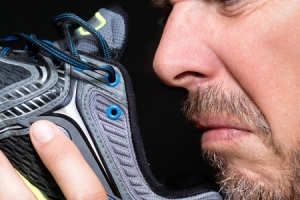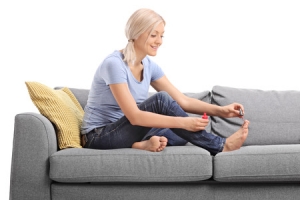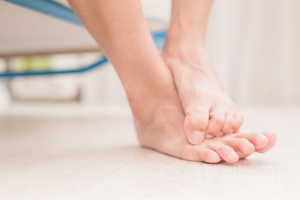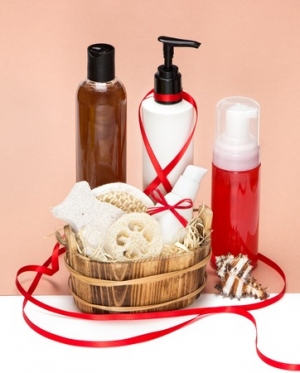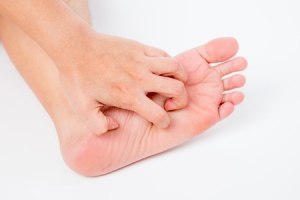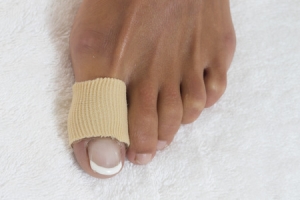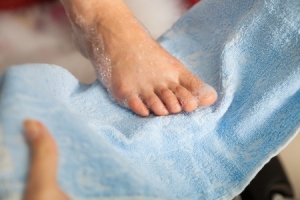Connect With Us
Blogs
Displaying items by tag: fungal infection
Don’t Try to Hide Foot Odor Problem
At Superior Foot & Ankle Care Center, one issue we notice, our Douglas Park/Los Angeles County area patients are often hesitant to bring up is foot odor. Smelly feet can be embarrassing, but it’s important that you discuss it with podiatrists, Dr. Victoria M. Foley and Dr. Constance Ornelas because sometimes it can be a sign of a fungal infection or another medical problem that needs to be addressed.
What Stinks?
The cause of the odor is usually a bacteria and/or fungus that is in your shoe and combines with the sweat on your skin to produce the foul odor. In some cases, a medical condition known as hyperhidrosis can be the source of year-round perspiration and stinky feet. If this is the cause of your smelly feet, the podiatrist can discuss treatment options with you. In most cases, however, some simple precautions can help you avoid the fungal infections that cause smelly feet.
- Wash your feet with soap every day and take the time to dry them completely. Be particularly diligent about drying the spaces between your toes as this is often the starting place for athlete’s foot.
- Don’t allow feet to stay in damp socks. Keep extra socks in your bag or desk and change multiple times a day if necessary. Moist, dark places are the ideal breeding ground for fungal infections.
- Never share shoes, socks, nail clippers, towels, or other items that touch another person’s feet.
- Avoid socks and stockings that are constrictive and trap moisture against your skin. Choose shoes made from breathable materials and have space to allow air to circulate around your feet.
- Alternate your shoes—don’t wear the same pair multiple days in a row.
- Keep feet covered by wearing flip-flops or shower shoes at the gym, community pool, nail salon or any other public place.
- If you notice red, itchy skin that’s scaly and/or blistering or toenails that are becoming thick and discolored, make an appointment at our Long Beach office by calling: (562) 420-9800.
Do’s and Don’ts for Protecting Children from Fungal Infections
Did you know that children have a higher incidence of fungal foot infections like athlete’s foot and toenail fungus than adults? The reason being that children are not as concerned with where they walk and keeping their feet clean. At Superior Foot & Ankle Care Center we’d like to offer the following do’s and don’ts to parents to help prevent children from contracting a fungal foot infection.
Do: make sure your child has a pair of easy, slip-on shoes to wear at the lake, beach, pool, or any other public place that tends to see lots of water and bare feet. These are the types of places where fungal infections love to lurk, and they are transmitted by direct contact. Even a quick trip to the bathroom or the changing area can result in picking up an infection if feet are not covered.
Don’t: let your child sit in damp socks. If your child has been running around and their feet get sweaty, have them change their socks. A child whose feet tend to sweat excessively may benefit from a dusting of talcum powder each morning before putting on socks.
Don’t: allow your children to wear shoes without socks. Bacteria and fungi can grow in the shoes and combine with the sweat from your child’s feet to cause infection and foot odor. It’s also a good idea to alternate footwear so that shoes have a chance to air out in between wearing them.
Do: tell your child not to share flip-flops or other shoes, towels, socks, soap, or other items that touch another child’s foot.
Do: wash your child’s feet every day with warm water and soap. If you notice redness, dry skin, flaking or blisters, or if your child complains of itchy feet, contact our Long Beach office for an appointment by calling: (562) 420-9800. Our podiatrists, Dr. Victoria M. Foley or Dr. Constance Ornelas, will examine your child’s feet and determine if a fungal infection is present.
A Beautiful Pedicure in 8 Easy Steps
At Superior Foot & Ankle Care Center we know that many of our patients enjoy getting professional pedicures but recent stories in the news about fungal and bacterial infections lurking at some salons may leave you feeling hesitant. If you don’t have a salon you trust to follow proper sanitizing procedures, we want you to know that you can give yourself a relaxing and pretty pedicure at home. Here’s how:
- First remove any old nail polish using cotton balls and nail polish remover.
- Fill a small tub with warm, soapy water and soak your feet for 5-10 minutes. Use a nail brush to gently scrub toenails and then rinse feet with clear water and dry.
- Rub a pumice stone or foot file on rough areas of the foot such as the heel and ball. This will exfoliate dead skin and help smooth calluses. If you have large or deep calluses or corns, make an appointment at our Long Beach office and let our podiatrists, Victoria M. Foley or Dr. Constance Ornelas safely remove or trim them.
- Trim toenails straight across and not too short. File the edges with an emery board. Do not curve the edges downward as this can lead to ingrown toenails.
- Gently push back your cuticles with an orange stick. Cuticles that extend from the nail margins can be trimmed using a cuticle trimmer. Do not cut so close that they bleed.
- Apply moisturizer to the cuticles and then the rest of your feet. Give yourself a soothing foot massage, using your fist to rub the balls of your feet and heel. Massage the top of your foot and your toes as well. You can also roll your feet on a bottle or rolling pin.
- Remove excess lotion from toenails with nail polish remover.
Brush on a base coat, then two coats of your favorite color and a top coat. Put your feet up and allow time for nails to dry completely. Enjoy!
5 Foot Symptoms and What They Mean
At Superior Foot & Ankle Care Center, we urge all of our patients to inspect their feet regularly and report any unusual changes to our podiatrists, Dr. Victoria Foley or Dr. Constance Ornelas. Sometimes, however, we find out that patients put off making an appointment at our Long Beach office because the change they’ve noticed just doesn’t seem that serious. Small changes can mean big foot problems, and your feet can also act an “early warning system” for diseases that can affect your whole body. Below are some changes in your feet and what they may mean:
- Red skin. Although short-term redness of the feet could just be due to temperature change or an allergic reaction to your laundry detergent, consistent redness can mean something more serious. Infections, such as athlete’s foot, can start with redness of the skin and an itchy rash. Consistently red or inflamed feet can also be a sign of the autoimmune disease of lupus.
- Black toenail. Unless you’ve recently stubbed your toe or you’re a runner, a black or discolored toenail is characteristic of a fungal infection. These may not be painful initially but will continue to progress and are contagious if not treated.
- There are several diseases which can cause excess fluid buildup (also called edema) in your legs and feet. These include: kidney or liver failure, heart disease and diabetes. If you are pregnant, a certain amount of swelling is normal but if in the last trimester of your pregnancy you experience sudden or excessive swelling, it may be a sign of a preeclampsia, a serious condition that requires immediate treatment.
- Cold feet. If your feet are always cold, regardless of the season or temperature, it can be an indicator of poor circulation. There are several possible causes for this, including diabetes, anemia and an underactive thyroid.
- Everyone gets a foot cramp occasionally, but if you are getting them regularly, it’s something to get checked out. In some cases, it may simply be a case of dehydration or a lack of certain minerals in your diet like magnesium, potassium or calcium. On the other end of the spectrum, however, ongoing foot cramps can be an indicator of nerve damage.
If you notice anything different about your feet or ankles—even if the changes are not painful or dramatic—contact us as soon as possible at: (562) 420-9800.
How to Have Healthy Feet
January is a good time for starting new habits, and we at Superior Foot & Ankle Care Center would like to urge patients to make this the year that you commit to better care of your feet. We believe in educating our patients to be proactive about the health of their feet. There are many ways that you can reduce your risk of injury and foot disorders and improve your podiatric health. Below are some suggestions:
- Wash your feet every day with mild soap and warm water. Dry them thoroughly, with particular attention to the area between the toes. This will significantly reduce the risk of athlete’s foot.
- Don’t walk barefoot. Out in public, walking without shoes increase your risk of coming in contact with a fungal infection. Even at home, you can protect your feet from stepping on sharp objects by keeping them covered.
- Get in the habit of inspecting your feet on a regular basis. The best outcomes for foot disorders occur when they are treated in their earliest stages. Being vigilant about reporting changes in skin or nail color, swelling, bumps or growths, bruising and cuts that don’t seem to be healing to our podiatrists, Victoria Foley or Dr. Constance Ornelas, can save you from prolonged and invasive treatments.
- Making wise shoe choices. Did you know that the single most significant step you can take to improve the health of your feet is choosing good shoes? Styles with roomy toe boxes that don’t constrict your toes, adequate arch support and laces for a firm fit can reduce the risk of falls, joint conditions, and toe deformities. In addition, getting away from wearing high heels can prevent neuromas and lessen the chances of bunions and several other podiatric problems.
- Apply sunscreen, not just on beach days but any days when the bare skin of your feet will be exposed in open sandals or shoes to the sun. The skin on your feet is just as susceptible to skin cancer as the skin on the rest of your body.
- Take care of toenails. Keep your nails trimmed straight across and not too short to prevent ingrown toenails from developing.
Better foot care needn’t be complicated or time-consuming. A few simple changes in your daily regimen can make a world of difference. If you have questions regarding the care of your feet, contact our Long Beach office today by calling: (562) 420-9800.
All Your Feet Want for Christmas
Dear Santa,
In the weeks leading up to the holidays, we have been working extra hard and trying our best to do everything we are asked to do. We have walked the mall looking for the best gifts, stood on line at the post office mailing cards and packages, attended several festivities and been putting in extra hours for house cleaning and cooking. Below is a list of gifts we are requesting:
- A visit to Superior Foot & Ankle Care Center. We’ve been hurting for a while now and the added pressure of the holidays has only increased our discomfort. We know that foot doctors, Dr. Victoria Foley, and Dr. Constance Ornelas will examine us and be able to provide a prompt diagnosis and treatment plan for what’s causing our pain.
- New shoes. We have a few comfy favorites, but honestly, they are getting a little worn out. The backs are stretched, and there is some frayed stitching on the toe that I am afraid is going to cause a trip or fall. In addition, it’s time to ditch some of the high heels and shoes with pointy toes—they are making our toes hurt, and we are worried that wearing them may cause a bunion to develop. We need to be professionally measured too because, over time, foot size can change.
- Professional pedicure. It would be relaxing to soak in a warm bath and then have my nails trimmed and polished in a festive color for the holidays. Of course, that’s only if the salon follows all the proper sanitizing procedures for sterilizing foot baths and nail tools so that we don’t end up with a fungal infection.
- Extra emollient moisturizer. With the heat on all the time, our skin is getting pretty dry. Flakes and itching are annoying enough, but we certainly don’t want to get to the point where cracks are opening in our heels. Thick and rich cream or lotion to put on our feet would be much appreciated. In addition, maybe a pair of fleece socks to put on after the lotion is applied would be great if it’s not too much to ask.
Are your feet trying to tell you something? If you have questions about unusual podiatric symptoms, you are experiencing or want to learn more ways to be proactive in caring for your feet, contact our Long Beach office today by calling: (562) 420-9800.
Facts about Athlete’s Foot
You may think you know about athlete’s foot—at least how to recognize it. A red rash that’s dry and flaky and itches and burns like crazy are the telltale signs. However, at Superior Foot & Ankle Care Center we know there’s more to know about this disorder than how it feels. Below are some important facts about this skin condition:
FACT: Athlete’s foot is a fungal infection. There are many different types of fungi that cause athlete’s foot. It’s necessary for our podiatrists, Dr. Victoria Foley and Dr. Constance Omelas to examine your feet and determine the fungus responsible for the outbreak in order to prescribe the correct medicine.
FACT: Athlete’s foot is easily spread to other parts of the body. Fungal toenails and jock itch, for example, can develop when you touch a spot on your feet that has athlete’s foot and then touch someplace else on your body. Athlete’s foot is also extremely contagious to other people.
FACT: Fungi love moist, warm, dark places. Gym locker rooms, the cement around the town pool, public showers, nail salons and the insides of closed-in shoes are all prime spots for fungi to grow.
FACT: You can greatly reduce the risk of getting athlete’s foot if you keep your feet covered when walking in public places and avoid sharing soap, towels, footwear, nail clippers and any other items that touch another person’s foot.
FACT: Personal care habits can also decrease your risk of athlete’s foot. You should wash your feet every day and dry them completely. Using a talcum foot powder on your feet before putting your socks on can help keep feet dry.
FACT: Your footwear choice is important if you are prone to athlete’s foot. Look for socks designed to specifically take moisture away from your feet. Change your socks during the day when you notice that your feet feel moist. Choose shoes that allow air to circulate and feet to breath.
Good podiatric care can help eliminate your chances of getting athlete’s foot. If you have a chronic fungal foot infection problem, contact our Long Beach office (562) 420-9800) to learn ways to get permanent relief.
Do’s and Don’ts for Dealing with Ingrown Toenails
It’s hard to believe how much pain such a tiny part of your body—a toenail—can cause, but if you have one that’s ingrown, you know what we’re talking about. The too-tender-to-touch, swollen, red, hot area surrounding your toe can make it difficult to wear shoes or even walk until it’s treated. At Superior Foot & Ankle Care Center we would like to offer the following tips for treating and preventing ingrown toenails:
Don’t: clip your toenails super short or file them with rounded edges—this encourages the nails to grow inward.
Don’t: wear shoes that are too small or narrow in the toe box. Ditto for socks and tights. Any type of footwear that forces the toes up against each other will increase the chances of ingrown nails.
Do: monitor a nail carefully if you’ve had an injury such as a heavy object fall on it, a bad stubbing or if you have another nail condition such as a fungal infection. In these cases, it is not uncommon for an ingrown nail to form.
Do: check your nails frequently if you are a runner, play soccer or participate in another activity where your toe is repeatedly being pounded up against the front of your shoe. This can cause a nail to become ingrown.
Do: soak your foot in warm water and Epsom salts if you notice a nail is ingrown. This may soften the skin enough so that you can gently massage the corner of the nail out of the skin. It may also bring pain relief.
Do: contact our Long Beach office for an appointment if soaking does not work. Our podiatrists, Dr. Victoria Foley or Dr. Constance Omelas will examine the nail and, if necessary, can perform a minor surgical procedure that will remove part of the nail border. Nails that are chronically ingrown may require the nail root to be removed.
Do: call us immediately at (562) 420-9800 if you notice signs of infection: pus, red streaks, fever.
Don’t: try any “bathroom surgery” or folk remedies to treat or prevent ingrown nails. Techniques like putting cotton under the nail, cutting a notch in a nail or repeatedly trimming nail borders as a new nail grows not only don’t work they can result in injury or infection.
Diabetes: Making Positive Choices
At Superior Foot & Ankle Care Center we know that diabetes doesn’t have to prevent you from living a full and active life. We treat many patients with this disease and we know it can have a big impact on the health of your feet. Diabetes impedes the circulatory and immune systems increasing the likelihood of infections and decreasing the body’s ability to heal. To make matters worse, neuropathy, a condition also commonly associated with diabetes, makes it difficult to perceive sensations like pain or heat which would signal a potential wound. The good news is there’s much you can do to protect your feet. In recognition of National Diabetes Awareness Month we’d like to focus on some particularly important areas:
Foot Care—Your feet can be both a recipient and an early warning system with regard to problems with diabetes. For that reason, inspecting your feet on a daily basis is essential. Changes in skin or nails, lumps, swelling, bruises, redness, blisters can all signal a potential problem developing. It’s critical that one of our foot doctors, Dr. Victoria Foley or Dr. Constance Omelas be informed of any unusual changes immediately. A good care regimen can also help decrease the risk of foot problems in diabetic patients. Wash feet with a mild soap in warm—not hot—water and dry completely, especially between your toes.
Shoes—Although well-made, properly fitted shoes can help reduce the risk of foot disorders in all patients, those with diabetes have specific concerns to address. Look for shoes that are well cushioned to reduce impact to the soles of your feet. Shoes should be laced and fit snugly (but not tight) to provide stability and limit side to side movement of the foot. If you have a toe deformity such as a bunion or hammertoe, special padding may be prescribed to prevent rubbing and friction which could lead to a corn or callus. Be sure the front of the shoe is roomy to prevent toes from being squeezed together.
Keep Feet Dry—Damp feet can lead to a fungal infection. If you tend to sweat profusely you can use a foot powder or even antiperspirant on the soles of your feet to reduce wetness. Change socks whenever you notice they are damp.
Healthy Lifestyle—Follow your doctor’s instructions for controlling your diabetes. Don’t smoke (it will further impede your circulation). Eat a healthy diet that is high in protein, vegetables and whole grains and limits saturated and trans fats and sugars. Exercise regularly for good joint health and weight control.
If you have additional questions about foot health and diabetes, contact our Long Beach office by calling: 562-420-9800.
What to Bring on Summer Vacation—for Your Feet
If you’re packing for a summer trip, your feet may not be the first thing on your mind, but at Superior Foot & Ankle Care Center we want to remind patients that if your feet are hurting on vacation, you won’t enjoy yourself. The good news is your feet won’t need their own bag, just a few small items that can have a big impact on comfort, health and safety of your feet. Here’s what to bring:
- Moleskin—it’s a good idea not to bring brand new shoes that you haven’t worn before on a vacation. Chances are you’ll be doing more walking than usual and when you’re away from your closet is not the ideal time to discover that the shoes you brought are uncomfortable. Sometimes, however, even previously comfortable shoes can start to rub if it’s especially hot and your feet are sweaty from the increased activity. Moleskin can save the day. Put a small piece on the part of your foot that is feeling irritated and it will hopefully help you get through the day without a blister. Of course, you should still change your shoes as soon as possible.
- Sunscreen—this is probably already in your travel bag, but make sure you remember to apply it to the tops and bottoms of your feet as frequently as you apply to the rest of your body. Don’t forget to reapply after swimming.
- Emery board and nail clippers—a rough nail can become torn and painful. Keep an emery board with you for filing and bring along your nail clippers too. Remember to clip toenails straight across to help prevent ingrown nails from forming.
- Extra socks—if your feet tend to sweat excessively or you know you’ll be in a warm place where you’ll be doing activities like hiking or sightseeing, change your socks as soon as you feel that your feet are damp. This will help prevent a case of athlete’s foot from becoming your vacation souvenir. Fungal and bacterial infections thrive in dark, damp places.
- Flip flops—use these around the pool or at the beach to prevent feet from coming in contact with fungi in public places. Don’t wear these as your everyday shoes however, or you risk injury and other painful foot conditions such as plantar fasciitis and flat feet.
If you do injure your foot while you are away be sure to seek treatment promptly and follow up by contacting our Long Beach, CA office for an appointment when you return. Our podiatrists, Dr. Victoria Foley and Dr. Constance Ornelas will want to check your foot and be sure that it is healing properly.
